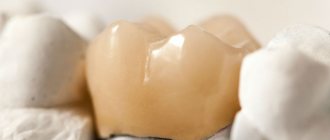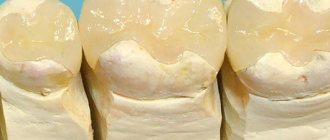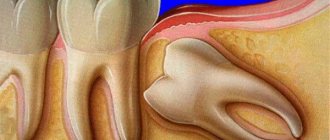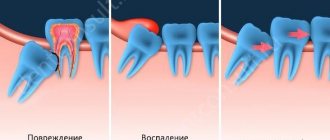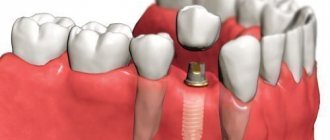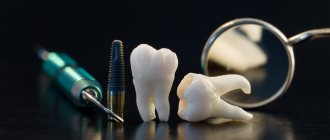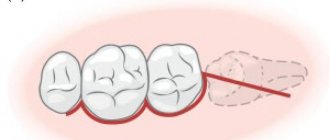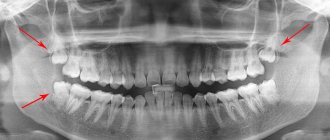Types and materials of crowns
Teeth 6 to 8 are not included in the concept of “smile zone,” and therefore doctors believe that their aesthetics should be the last thing to worry about. Many people install the simplest, stamped metal crowns. Not only do they look creepy, but the surface is not at all adjusted to the rest of the teeth. That is, it is simply a “metal part” in your mouth. The cheaper it is, the less anatomically correct it is made and the worse the condition of the ground tooth underneath it will be. Therefore, most experts recommend installing metal ceramics.
A crown can be for one tooth or several. Sometimes, when you need a prosthesis for 2-4 teeth, a whole bridge is placed on special fasteners that hold on to healthy teeth.
First of all, we will talk about restorative crowns. They are used to return a person to the ability to chew normally. There are several main types.
- Full crown . It replaces the destroyed natural one completely.
- Stump - recessed type. If the tooth is almost completely destroyed, this option is the most convenient and aesthetically pleasing.
- With pin . Option for severely damaged teeth.
- Half-crowns . Cover all sides except the inner (lingual). They are often used to mount bridges and other types of prostheses.
In any case, the crown for a chewing tooth is selected taking into account the increased load.
If the patient insists that the tooth should look as natural as possible, prosthetics using crowns on a zirconium frame is recommended.
- Zirconium dioxide has an important advantage over conventional metals and alloys. It has natural light transmission close to that of a real tooth.
- The second big plus is the strength of such products, which is greater than that of standard metal-ceramic ones. Indicated up to 600-700 MPa.
- Long service life (a well-placed crown will last up to 20 years).
- Light weight.
- Low thermal conductivity.
- Individual fit with high precision.
- It is easy to achieve the correct shape, anatomical accuracy of the chewing surfaces, and match the color to the enamel of adjacent teeth.
High accuracy of fitting of such crowns is ensured due to the fact that this is done using computer modeling. Therefore, the errors amount to hundredths of a millimeter. When it comes to getting an exact replica of the tooth you are going to chew on, it is important that it is the right height and shape. Otherwise, the load on the maxillotemporal joint will be uneven, which can lead to various disorders.
A pin insert made of fiberglass or titanium can also be used. In the first case, we get transparency - the base is not visible through the crown. In the second case - increased strength.
Types of dental crowns, comparative analysis, differences, advantages, disadvantages, prices
Modern dentistry offers a wide selection of prosthetic methods, even if there is almost nothing left of the molar.
Types of dental crowns by material
For older people, the word “crown” is often associated with gold teeth. However, we should not forget that dentistry has come a long way. Now such dentures are almost indistinguishable from real teeth. The main differences between crowns are the material they are made of and the method of attachment. The appearance of the prosthesis and its strength depend on it.
Dental prosthetics with crowns
Dental prosthetics with metal-ceramic crowns
Metal-ceramic crowns are made on a cast metal frame. A layer of ceramic is applied on top, resembling natural enamel in appearance.
Typically, nickel-chromium and cobalt-chromium alloys are used as the frame. Patients can also order dentures based on alloys that contain gold, platinum and palladium. This type of metal does not oxidize over time, providing a more aesthetic appearance of the product. Advantages of metal-ceramic structures:
- Reliability and durability. Inside the crowns there is a cast metal frame. Under normal chewing loads, such structures last a very long time. One of the troubles that can happen is chipping the enamel. But the prosthesis can always be quickly restored directly in the oral cavity.
- The ceramic layer is not painted and is not subject to the erasing process. Also, this material does not contribute to the occurrence of caries. Prosthetic teeth will always be white and straight.
- Crowns of this type are installed on individual dental units. They are also used to create bridges.
- Metal and ceramics have hypoallergenic and antibacterial properties. During operation there are no allergies, inflammatory or infectious diseases.
Indications for installation:
- loss of 1 or more molars;
- if the front teeth have been destroyed as a result of injury and there are contraindications to the placement of inlays and veneers;
- intensive abrasion of enamel;
- if there is a splinted tooth due to mild periodontal disease;
- if the molar is destroyed by more than 50%.
Contraindications:
- severe forms of periodontal disease or periodontitis;
- allergy to certain components;
- bite problems;
- bruxism;
- mental disorders;
- drug and alcohol addiction.
Let's consider the main stages of metal-ceramic prosthetics:
- During the first consultation, the dentist carefully examines the oral cavity. At this stage, a treatment protocol is drawn up and the type of crown is selected. An x-ray is taken. To ensure that the product fits perfectly, everyone is recommended to have their mouth professionally cleaned. Plaque and stones are removed.
- Next, you need to work with problematic molars. If necessary, the doctor removes the nerve and fills the canals. Since metal-ceramic dental crowns are thick, a healthy tooth is ground down as much as possible. After this, the orthodontist takes an impression. Based on it, a crown is created in a dental laboratory. During this time, the patient is fitted with a temporary plastic structure.
- Making a prosthesis. First, a metal frame is formed. A layer of enamel is then applied to it by hand. The technician has a special color scale. Therefore, choosing a crown color that is similar to real teeth is not difficult.
- The product is ready and sent to the clinic. In most cases, the patient is first asked to temporarily wear the crown. If the patient feels discomfort, the product will be sent for revision. If everything goes well, the dentist places the crown using dental cement.
After installing the prosthesis, you should follow simple rules:
- avoid sudden temperature changes;
- do not chew hard food (for example, do not try to crack the shells of nuts);
- visit the dentist every six months;
- Perform oral hygiene regularly.
Compliance with the above rules is the key to long-term service of the prosthetic structure.
Dental prosthetics with ceramic crowns
Dental prosthetics with ceramic crowns
Today, ceramic tooth crown Patients are attracted by the affordable cost, as well as the optimal combination of aesthetics, reliability and practicality. Medical ceramics are capable of transmitting light, so the artificial unit looks exactly like a natural tooth. Depending on the ceramic material, several types of products are distinguished:
- porcelain (with the addition of ceramics);
- all-ceramic;
- mixed (zirconium and ceramics).
Advantages of dental crowns:
- identical to real teeth;
- biological compatibility with mucous membranes;
- do not cause allergic reactions;
- lightweight design allows you to install dentures on weakened teeth;
- ceramics do not stain and do not fade during the entire service life;
- there is no pain reaction to cold and hot food;
- teeth can be subjected to minimal grinding when installing a crown;
- long service life.
Indications for installation:
- damage to the crown parts of the incisors;
- abnormal size, location and shape of teeth;
- excessive abrasion of enamel;
- aesthetic defects of the crown part of a natural tooth.
Contraindications:
- inflammation of the oral cavity;
- exacerbation of chronic diseases;
- pregnancy;
- severe osteoporosis;
- mental disorders.
With proper care (carry out oral hygiene 2 times a day, use rinses and dental floss, do not put excessive pressure on the crown), a ceramic product will last from 10 to 15 years. However, it will not change its shade, shape or structure. Also, the prosthetic structure will not be affected by caries and will not accumulate plaque.
Doctors' recommendations
For example, you have a damaged tooth and you want to stop the process of its destruction. In this case, you can install a completely aesthetic metal-free crown. They are made of ceramic, very similar to real teeth, but are quite expensive. Therefore, it can be expensive to place them on a chewing tooth.
If you need to combine reliability with a certain level of aesthetics, it is recommended to use metal ceramics. The frame of such products is made of nickel-chromium and cobalt-chromium alloys. For “distant” teeth, metal crowns can also be used.
The most important point is preparing the tooth for the installation of such structures. After all, in order to place a crown, the tooth is ground down, the nerve is removed from it, the root canals are cleaned and filled. If the filling is not done well enough, an inflammatory process may begin. The most unpleasant moment in this story is that inflammation begins late, when the warranty on the artificial tooth installed for you expires. In the CIS they rarely give a guarantee of more than a year. For comparison, in Germany high-quality crowns have a warranty period of up to five years. Tell me, we don’t have such specialists? Yes, but they still don’t risk promising that your crown will last that long.
It is difficult to treat extreme teeth
Another reason why doctors prefer not to treat “figure eights” is complicated access. The patient cannot open his mouth wide enough, he often has a gag reflex, it is difficult to work with instruments in this area, and the close proximity of the cheeks, gums and tongue interferes.
In addition, before prosthetics, depulpation is required. However, high-quality endodontic therapy of extreme units is impossible. She is hindered by:
- inconvenient location;
- unpredictable number of channels;
- high probability of the presence of microtubules that are not visible on x-ray;
- twisted roots.
Important! If the outermost units are severely damaged, they must be removed. There is no point in installing a single crown and saving a tooth with a non-viable root system.
Prices
For many people, the question of which type/material to choose comes down to financial issues. That is why in our country there are so many people with “iron” teeth. After all, a beautiful metal-free crown for a chewing tooth can be quite expensive.
I simply entered prices into a search engine and was surprised at the range. For example, in St. Petersburg they ask for 35 thousand rubles for one zirconium crown. At the time of this writing, it was $533. But, after scrolling through several offers from clinics in other cities (both the Russian Federation and Ukraine, Belarus), I was convinced that there are much cheaper options. For example, Kiev residents offer the same service for $149. The Moscow clinic asks for 25 thousand rubles. (379 USD).
But this is all based on zirconium dioxide prices. Conventional cermets are cheaper; metal costs pennies compared to these prices. So here it’s up to you to choose - to install one that is less aesthetically pleasing, average in terms of parameters, or almost ideal, but more expensive.
For example, from the above-mentioned Muscovites you will pay around $200 per tooth for high-quality metal-ceramics. A metal-plastic crown will cost $73.
Features of dental crown care
If you have a simple single crown installed on a tooth, then a toothbrush, paste and floss will be enough for care. But if you have a bridge installed (or, as it is also called, a bridge), then certain difficulties will most likely arise with hygiene. The fact is that such dentures have an intermediate part (it is what restores the lost tooth), food debris accumulates under it, which is sometimes very difficult to remove.
But regular hygiene is not everything. I also recommend using irrigators that allow you to clean the most inaccessible areas of the oral cavity (for example, under the same bridge) from soft plaque and food debris. Irrigators form a pulsating water stream under pressure and deliver it through a special nozzle.
Zirconium dental crowns – features and benefits
Once zirconia-based crowns appeared, dentistry changed dramatically. Products made of plastic, metal, porcelain and all ceramic analogues have faded into the background. Advantages of zirconium dental crowns:
- Strength. Zirconium dioxide is similar in strength to natural enamel. They even make bridges based on it.
- Maximum resemblance to real teeth. Zirconium dioxide is a snow-white material. Crowns based on it are ideally suited to the dentition. With the correct color selection, the patient’s dentition is no different from natural.
- Metal-free ceramics are absolutely safe for health. This type of prosthetics is suitable for people with metal allergies.
- High-quality products last from 8 to 10 years.
Zirconium crowns are made using high-precision computer equipment. The laser scanning technique allows you to accurately analyze the patient’s dentition. Based on the information received, a computer program models the future crown for the tooth. This data is digitally transferred to the milling machine. Next, the structure is machined from zirconium blanks.
Implant supported crowns
What to do if a tooth is completely missing? Or is it there, but it is destroyed to such an extent that it is impossible to put a crown? In this case, you can install a bridge, but then you will have to grind down the supporting (adjacent) teeth. Today, dentistry presents an innovative method of restoration - installing a dental crown supported by an implant.
This product can replace completely lost incisors. The implant itself is an artificial tooth root. It is implanted into bone tissue. Next, the abutment is installed. After complete implantation, the crown is attached directly.
What kind of dental crowns are placed on implants? This is a common question from patients. Use:
- metal-ceramic - cost from 10,000 rubles;
- metal-free (from zirconium dioxide) – price from 46,000 rubles.
Other materials are not used, as they do not look very aesthetically pleasing.
Standard treatment regimen:
- Visiting the dentist. The doctor examines the oral cavity. If necessary, prescribes dental or periodontal treatment.
- The orthodontist makes an impression of the patient's jaw. Based on the data obtained, a frame is made in a dental laboratory. A special coating is applied to it. The use of modern three-dimensional computer modeling technologies makes it possible to produce an artificial tooth that is exactly similar to the real one. The crown is made within 1-2 weeks.
- Implantation. Depending on the complexity of the case, the implantation of the support and the formation of the gums take from 2 months to six months. During this time, the implant will be positioned in the gum. A special shaper is used to create the contour. When the healing process shows a positive result, the dentist installs a crown.
Second option for installing on an implant:
- immediately after tooth extraction, an artificial root (pin) and temporary structure are installed;
- After engraftment, the dentist changes the temporary product to a permanent one.
Advantages of this treatment protocol:
- a person gets used to the feeling of a foreign body in the mouth;
- the implant area is isolated from microorganisms by a kind of “cap”;
- thanks to the temporary crown, the chewing load is distributed evenly.
Important! All stages of treatment are carried out under the strict supervision of the attending physician! If you experience the slightest discomfort, you should immediately contact the clinic where you received the implant and crown.
Porcelain crowns
A porcelain tooth crown is a ceramic structure that does not contain metal. Modern dentistry uses these products for aesthetic restorations. Porcelain structures are installed for patients who are allergic to metal impurities. For this type of structure, special porcelain-based mixtures are used. They are inert, which means that the crown does not irritate soft tissues and does not stain over time. Porcelain dentures are installed on the front and side teeth.
Indications for installation:
- If the patient has allergic reactions to: metal, plastic. Porcelain is highly compatible with soft tissues of the oral cavity. It does not cause allergies, inflammation or irritation.
- Dentures are used to restore molars in the smile area. Porcelain allows sunlight to pass through, so its color resembles the natural shade of tooth enamel.
- Restoration of teeth affected by caries and other dental diseases.
- Correction of the shape and position of the cutter. Please note that porcelain products are installed only if the teeth are slightly crooked.
Contraindications:
- malocclusion;
- periodontal inflammation;
- root damage.
Stages of production of porcelain structures:
- examination by a dentist, diagnostics of the oral cavity;
- tooth preparation and color selection for the future crown;
- taking a dental impression and transferring it to a technician in the laboratory;
- making a crown (a thin platinum foil is used for the base of the crown, which is installed on the model and filled with porcelain);
- step-by-step processing of the prosthesis under the influence of high temperatures;
- manual frame adjustment;
- installation of a porcelain dental unit.
Advantages:
- natural appearance;
- strength and wear resistance;
- long service life without visible changes;
- biological inertness to the human body.
Flaws:
- increased fragility;
- loose fit at fixation points;
- high abrasiveness, which has a detrimental effect on adjacent contacting teeth.
In Moscow's capital clinics, installing a porcelain crown costs an average of 15-25 thousand rubles.
Crowns on a gold frame
dental crown consists of a metal frame with the addition of an alloy of noble metals and a layer of ceramics. All parts are connected under high temperatures.
Pure gold is rarely used for the production of prosthetics, despite the fact that it perfectly adapts to the human body and is highly durable. Therefore, in dentistry, an alloy of gold with other metals is used to create a frame. Among them: palladium, silver, copper, etc.
These elements change the physical characteristics of the prosthesis for the better. For example, the strength of the crown increases, while maintaining the high biological compatibility of the alloys. In addition, these materials have antibacterial properties.
The main advantages of dental crowns on a gold frame:
- natural appearance of artificial teeth;
- reliability and practicality (average service life 10-15 years);
- such dentures can replace any teeth: incisors, chewing teeth, etc.;
- there is no traumatic effect of the crown on the gum;
- no allergic reactions;
- The plastic frame adheres well to the tooth tissue, preventing atrophy of the soft tissue.
The product on a frame made of a gold-containing alloy is the standard in prosthetics with metal-ceramic structures. The only drawback is the high cost compared to other similar prostheses.
Could there be any problems?
Metal-ceramic crowns are very durable, this is the optimal material for prosthetics even for front teeth, not to mention chewing teeth, but there is one unpleasant nuance that you should be aware of. We are talking about darkening of the gum edge. Moreover, this can be observed both immediately after installation and after a certain time.
What is the reason for this phenomenon? Darkened gums are a metal frame that protrudes through the mucous membrane. In this case, everything depends on the characteristics of the smile: if the gums are visible during it, then the defect described above will also be noticeable.
Reviews about crowns
What do people themselves say about installed crowns made of various materials? I'll start again with the expensive ones, zirconium ones. That's what's really good about them - doctors try much harder for that kind of money. After all, their mistakes will lead to customer dissatisfaction and the need to redo everything. And this work is very difficult. That’s why they strive to do everything right and efficiently right away.
Prices have increased significantly in recent years. If in 2013 a Russian could get two zirconium crowns for 35 thousand rubles, then by 2020 he can only get one. People only complain about the cost. For many people it is simply too much to bear. After all, many people live on a salary/pension of 15-20 thousand. Save for a year? An option, but it doesn’t suit everyone.
Next, let's move on to metal ceramics. The biggest problem is to find good specialists who will carry out the procedure correctly so that you do not have problems in the future and do not have to remove the tooth on which the crown is placed. In general, for chewing teeth, crowns of this type are optimal in terms of price and quality.
The most negative comments came from metal-plastic and cast metal crowns. Metal-plastic crowns have one unpleasant property - the plastic coating simply peels off over time, exposing the metal base. The view is not the most pleasant. Also, gums often become inflamed under cheap crowns, and gingivitis has to be treated.
Still, 90% of negative reviews are not related to the materials, but rather to the incompetence of doctors. Therefore, I can recommend studying opinions about the clinic you have chosen, and then trusting its employees with your teeth and money.
To summarize, I want to say – you shouldn’t skimp on your dental health. I wish you good luck in choosing a clinic and crowns. I look forward to your comments and subscriptions to site news.
expertdent.net
Modern dental materials for crowns make it possible to restore the functionality and aesthetic appearance of teeth, prevent the development of caries and further destruction of dental tissues. Crowns are even placed on third molars, the so-called wisdom teeth. Although the eighth teeth in a row practically do not perform the function of chewing, they are still capable of acting as:
- supports when installing bridge prostheses;
- restraining supports that prevent the adjacent tooth from loosening;
- backup option - if several chewing teeth are lost, the third molars take on part of the load.
A crown is placed on the 8th tooth in order to preserve healthy tissue, since third molars provide a clear advantage in subsequent prosthetics. Wisdom teeth erupt much later than others, so when neighboring teeth are destroyed or lost, they can be used as support for bridge crowns. If you do not save the eighth tooth, prosthetics will no longer be possible with a crown, but only with an implant. A wisdom tooth may be needed to install a bridge crown when replacing the removed anterior seventh molar, the sixth and seventh molars that are missing or need to be removed.
Healthy “eights” are rarely found in people. But if there were no complications during the eruption of the wisdom tooth, and there was no displacement of the dentition, then you should not remove the molar. Even if a tooth is damaged, treatment and restoration are still possible. But it is quite difficult to place a crown on the 8th tooth, which is caused by an uncomfortable position in the oral cavity and a complex anatomical structure. The difficulty of installing a crown on the 8th tooth is also due to the frequent curvature of the root canals, which need to be properly filled.
Dental clinic "Mendeleev" offers the manufacture and installation of crowns on teeth on a turnkey basis. Orthopedic doctors successfully perform even the most complex dental prosthetics, including third molars. The tooth crown is made in the clinic’s own laboratory using modern dental materials. A dental crown can be made of metal-ceramics or zirconium dioxide-based ceramics. This crown exactly recreates the shape, size, color and transparency of a natural molar. A high-quality crown is almost impossible to distinguish from the patient’s natural tooth. The dentist selects a crown for a tooth during a personal consultation, taking into account the clinical picture, condition of the oral cavity, individual preferences and budget of the patient.
me-dent.ru
The best dentists
Promotions for dental prosthetics at Premier Clinic In the modern world, young people can lose their teeth due to changes in lifestyle and diet. Today, more than 90% of the world's population suffers from caries. This is why dentistry has developed so much over the last 50 years. Today, many technologies have been created for restoring teeth of varying degrees of destruction. Despite the emergence of new prosthetic technologies, bridges remain one of the most popular types of dentures.
They are placed on any teeth, but to do this, one should take into account the structural features of the dentition and the installation location. Many patients are interested in whether it is possible to place a bridge on a wisdom tooth when restoring posterior chewing teeth. Everything in each specific case depends on the condition of the tooth itself and the entire oral cavity.
In our “Premier Clinic” you can install a bridge on chewing teeth, on the front, side, and back. The bridge design of the prosthesis has a number of advantages:
- it is universal and suitable for installation on different teeth;
- can always be selected on an individual basis;
- can be made of different materials;
- allows you to restore teeth of any degree of destruction.
Do they put a crown on a wisdom tooth?
Wisdom teeth sounds unusual and seems to imply some special difference between late appearing teeth and all others.
In fact, these teeth are completely ordinary, and the whole difference lies in the timing of eruption.
What makes them special is the attitude of dentists towards these difficult-to-treat teeth in the depths of the oral cavity: some doctors advocate the unequivocal removal of the figure eight, the second part advises preserving them at the slightest opportunity.
It is better to preserve a wisdom tooth if a number of conditions are met:
- There is an antagonist - that is, a similar tooth in the upper or lower row, actively performing a chewing function and in contact with the tooth, the fate of which is being decided in the doctor’s office.
- This wisdom tooth will be needed later, many years later, if the need for dental prosthetics with crowns suddenly arises.
- Caries or pulpitis of a problematic wisdom tooth can be treated qualitatively with the installation of a pin or crown.
Unfortunately, some general practitioners are too lazy to engage in long-term and labor-intensive treatment of wisdom teeth. Here you will need to show dexterity, because it is quite difficult to operate with instruments in the depths of the mouth.
It is much easier to remove a tooth, and often the patient - especially at a young age - agrees to this proposal, trusting the doctor. In addition, few people think about the situation that may arise many decades later.
The sixth and seventh teeth, experiencing heavy chewing load, can collapse beyond repair. If the wisdom tooth were in place, it would be possible to install a bridge. And without it, a so-called “end defect” appears in the dentition. There are only two options: installation of a removable denture, or expensive dental implantation.
Delete or leave?
The situation when a decision is made - to remove or preserve a wisdom tooth - requires a detailed consultation with a dentist. If the tooth can be saved, and the doctor offers a choice of a crown or filling, do not rush to save money (the crown will cost more).
It is better to listen to the doctor’s advice and trust a competent specialist, weighing all the chances. It happens that a filling placed at risk to a tooth destroys it partially (and this will require a repeat procedure) or completely.
In the latter case, nothing can be done.
It's a different matter when the wisdom tooth is badly neglected. For example, a patient came to the doctor with granulomas on the roots - removal according to the general rules is indicated here.
Or the wisdom tooth initially erupts incorrectly (lays on its side, rests against the wall of another tooth, looks towards the cheek) - and in this case, removal is inevitable.
Also, a wisdom tooth is removed if its appearance means a decrease in space for the growth of other teeth - with a short jaw arch.
Remember, the decision to preserve or remove a tooth is made only on the basis of an x-ray, which will clearly show how normal or pathological the tooth is. If the doctor advises you to get rid of your wisdom tooth immediately after a visual examination, change the clinic or doctor.
Source: drlopaeva.ru
5 interesting nuances of wisdom tooth prosthetics
If the dentist insists on preserving the almost destroyed “eight”, you need to take into account 5 nuances when replacing wisdom teeth that you did not know about. Third molars are the most “problematic” units. Before treating them, you need to consider all possible risks. Otherwise, your efforts and money will be wasted.
Serious indications are needed for wisdom tooth replacement
Most dentists are of the opinion that it is better not to treat third molars, but to remove them immediately. Even if they have ordinary caries. This position is justified for several reasons:
- only in 2% of patients all wisdom teeth grow without problems and occupy a physiological position in the row;
- extreme units are almost not involved in chewing food;
- It is rarely possible to provide high-quality therapy.
The problems with "eights" are due to the fact that they are vestigial elements. Human ancestors needed them to chew tough, unheated food.
But gradually the chewing load decreased, the third molars became unnecessary, and the jaw decreased by 10 - 12 mm.
The outermost units usually do not have enough space, they grow in the wrong position or do not erupt at all.
Therefore, wisdom teeth prosthetics are not advisable. It is performed only if the patient:
- all “eights” are completely cut through, do not interfere with the growth of other units and do not cause inconvenience;
- the “sevens” and “sixes” in front have been removed;
- there is a high risk of losing the 1st and 2nd molars;
- the prosthetic wisdom tooth has an antagonist on the opposite jaw.
In this case, the extreme units can become a support for a bridge or removable prosthesis. But even if the patient’s remaining molars have been removed, dentists insist on replacing them with implants. The installation of an orthopedic structure, as a rule, is not due to medical indications, but to the financial difficulties of the patients and the lack of technical capabilities at the clinic.
Additional Information! A serious reason for wisdom tooth replacement may be the risk of malocclusion.
If the units are too close together, they may become displaced after the third molar is removed.
But this situation is extremely rare, and when it occurs, it is preferable to correct the occlusion with orthodontic treatment. Also a serious complication are the symptoms of alveolitis, which cannot be ignored.
It is difficult to treat extreme teeth
Another reason why doctors prefer not to treat “figure eights” is complicated access. The patient cannot open his mouth wide enough, he often has a gag reflex, it is difficult to work with instruments in this area, and the close proximity of the cheeks, gums and tongue interferes.
In addition, before prosthetics, depulpation is required. However, high-quality endodontic therapy of extreme units is impossible. She is hindered by:
- inconvenient location;
- unpredictable number of channels;
- high probability of the presence of microtubules that are not visible on x-ray;
- twisted roots.
Important! If the outermost units are severely damaged, they must be removed. There is no point in installing a single crown and saving a tooth with a non-viable root system.
"Eights" have weak roots
Even if wisdom teeth have grown normally, their roots always remain underdeveloped. They can hardly withstand the insignificant load that falls on them alone.
If you replace the removed units with a bridge, the main supporting tooth will be the remaining intact molar or premolar – “six” or “five”. This will lead to rapid destruction of the crown and root system. As a result, the patient will waste money on orthopedic treatment and will have to install one more implant in the future.
Additional Information! In the place of the erupted “eight” there are always immature mesenchymal cells that do not resolve. They can provoke the development of tumors and cysts.
Third molars are difficult to care for
Dentures require more careful care than “your” teeth. How long the structure will last depends on the quality of hygiene. But in the case of third molars this is very difficult.
In the corner of the row, food particles and plaque constantly accumulate, actively decomposed by microbes and bacteria. They are extremely difficult to clean completely. And due to the fact that the “eights” are almost not involved in the chewing process, they do not clean themselves.
As a result, hard deposits and stones build up on the orthopedic structure. They not only damage the prosthesis, but also provoke inflammation of the mucous membrane.
The prosthesis will not last long
On average, a high-quality prosthesis costs from 5 to 10 years. And this is subject to regular preventive examinations, corrections and good hygiene.
If the orthopedic design is installed on the extreme units, the service life is reduced by at least 2 times. It won't last more than a couple of years. But, most likely, problems will appear in the first months.
When the question arises about replacing a lost molar, it is better to choose implants. If the dentist insists on placing a bridge on a wisdom tooth, you should play it safe and consult with 2–3 more doctors. There is no need to immediately agree to orthopedic treatment - the contraindications to it are too serious, and therapy in most cases will be a waste of money and time.
Source: zubivnorme.ru
Implantation of “eights” – is it necessary to restore wisdom teeth, and in what cases is this possible?
Wisdom teeth - third molars or "eights" - are considered a rudiment and, for the most part, are not needed by modern humans for chewing food. They erupt late, usually after 25 years, or do not erupt at all.
Very often, “eights” have to be removed, but not everyone knows whether it is necessary to install an implant instead of a wisdom tooth.
In today’s article we will tell you when and how implantation is carried out in place of figure eights, and in what situations it is not needed.
Source: https://intell-dent.ru/stati/na-zub-mudrosti-stavyat-li-koronku.html
How to place a bridge on back teeth
The bridges have a special design. The two outer crowns on them are hollow. They are installed on the supporting teeth, which ensures the strength of the attachment. Those crowns that stand in the middle of the bridge are closed. They simply lie on the gums, imitating restored teeth. It is impossible to install a bridge without supporting crowns. Therefore, if there are no such teeth, an implant is placed, which serves as a support.
Before installing a bridge on a wisdom tooth or front teeth, it is necessary to carry out oral treatment. Bridges are always installed on a permanent basis. To install them, it is necessary to file down the supporting dental unit. If necessary, the nerve must be removed from the tooth so that it is no longer under the crown.
Oral health
[user blocked] [143K]What's the problem ? As a dentist myself, I have placed so many crowns on my patients’ wisdom teeth that I can’t even count them! It’s another matter when the wisdom tooth is dystopic (change in normal position) or simply “neglected” with cysts on the roots - then, of course, it’s not worth it, but these are general rules for all teeth! The problem is to find a normal doctor who can fill the canals with high quality wisdom tooth (if necessary, for example with metal-ceramics) For high-quality treatment, a wisdom tooth presents certain difficulties (the location is inconvenient for the doctor - manipulations become more complicated). And doctors these days are quitters, how many times have I heard - “So it’s your wisdom tooth - you’d better remove it - these are usually ladies - therapists - they’re just too lazy to “pick around” somewhere in the depths of the oral cavity! It's much faster to heal a front tooth! And in their youth they most often accept this offer! And later they regret it, because, say, they lost the 6th and 7th teeth and it turns out to be a “terminal defect” - that is, either a removable denture or implants! In any case, a normal doctor will take an x-ray to check the filling of the canals - and if everything is normal, then you can easily and even need to put crowns on your wisdom teeth! As an example, I’ll post an x-ray image, where
The wisdom teeth are normal – you can see for yourself that there is nothing special about them!
the author of the question chose this answer as the best
Afana siy44 [315K]
If there are indications for this - a small carious cavity or the need to use a wisdom tooth in a bridge, then it’s definitely worth it.
An x-ray is needed to assess whether the eighth tooth is suitable for a crown.
My crown on the “wise” tooth has been part of the bridge for 15 years and nothing.
Rudel ina [33.2K]
more than a year ago
A wisdom tooth is still a tooth, and you need to take care of it. Indeed, dentists are not in a hurry to suggest putting a crown on this tooth. Because there is more work, the work is almost like jewelry.
This was the case in my case. They put a crown on a wisdom tooth, made a beautiful metal-ceramic bridge, but alas. The entire structure lasted for about two years; a bedsore formed nearby from an ineptly installed bridge. I had to remove everything and treat it. I’ll try to repeat it in a paid clinic. The doctor agreed, but also not right away! It’s clear who wants to tinker, the case is complicated. But how beautiful! Therefore, crowns are placed on wisdom teeth, the main thing is
find an experienced specialist.
more than a year ago
If the wisdom tooth is healthy - the enamel is intact, there is no darkening and there is no reaction to hot or cold, it does not bother you in any way, then it can be used for a crown on which the prosthesis is attached. But the wise tooth is located near the jaw joint and access to it is limited. The doctor will have to try to be clever in order to use it.
An impression of the tooth is made for the crown. After fabrication, the tooth is ground and a crown is glued and placed on it. All this can almost be felt somewhere near the pharynx. Not every doctor will take the job, but rather will advise removing a distant tooth.
When the need arises to install a prosthesis using a wisdom tooth, look for a good doctor.
more than a year ago
It all depends on the condition of the wisdom tooth. Often such teeth are already diseased and have to be removed, so what’s the point of putting a crown on it?! For example, this is exactly what happened to me. The teeth came out, but they were already sick, I had to remove them.
If the tooth is healthy, then why not. So, even better - an extra tooth in the mouth)
If the wisdom tooth comes out straight and is healthy, then it is quite possible to put a crown on it. Typically, a crown is needed to hold a bridge in place of one or more chewing teeth that have been removed. And if the wise tooth is subject to treatment, it is usually removed.
Tatya na Neg [62.9K]
The wisdom tooth must be protected to the last. A crown and a crown. The doctor advised me: in order not to treat the wisdom tooth anymore, pull it out. And I proved in detail that brushing my teeth will be easier, and I will save the previous tooth. In general, some advantages. I went to pull it out. Pulling out this tooth broke my previous one. And I had to put a crown on the previous one. I could have saved it.
Lyaksa ndr [143K]
8 months ago
In general, of course, they put crowns on wisdom teeth. This prevents the tooth from starting to crumble later. But this is despite the fact that the tooth itself is quite healthy, the canals are well treated and sealed, there is no pus on the roots, etc. There are different situations. It happens that a tooth needs to be saved, but there are such teeth, especially “wisdom” ones, that they are curved and there is pus on the roots, etc. Then it is better to remove such a tooth. But all this must be decided by a good doctor
Shipo 3 [29.1K]
more than a year ago
The situation must be assessed by a dentist. If the tooth as a whole is subject to treatment and is located normally (for example, I have a tooth that has come out halfway, so there is no need to put on a crown), then it is quite possible to get a crown; there are no extra teeth, and new ones will not grow.
Bridge on front teeth and other types of teeth
Before installing a bridge, you need to go through several steps:
- conduct an oral examination;
- heal damaged teeth on which the bridge will be installed;
- make impressions;
- make bridges;
- carry out adjustment and installation.
Installing a wisdom tooth bridge on your front, side or back teeth requires a lot of work. Only in this case will the bridge be made and installed well.
To make a bridge you can use:
- metal;
- ceramics;
- metal ceramics;
- plastic.
Each type of material uses its own bridge manufacturing technology. It is also important for the bridge to make high-quality impressions of the teeth so that the bridge and crowns fit optimally into the dentition.
The prosthesis will not last long
On average, a high-quality prosthesis costs from 5 to 10 years. And this is subject to regular preventive examinations, corrections and good hygiene.
If the orthopedic design is installed on the extreme units, the service life is reduced by at least 2 times. It won't last more than a couple of years. But, most likely, problems will appear in the first months.
When the question arises about replacing a lost molar, it is better to choose implants. If the dentist insists on placing a bridge on a wisdom tooth, you should play it safe and consult with 2–3 more doctors. There is no need to immediately agree to orthopedic treatment - the contraindications to it are too serious, and therapy in most cases will be a waste of money and time.
Source: zubivnorme.ru
